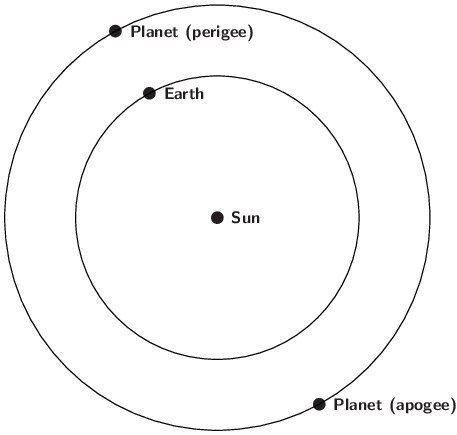Mars will reach opposition, when it lies opposite to the Sun in the sky. Lying in the constellation Virgo, it will be visible for much of the night, reaching its highest point in the sky around midnight local time.
From South El Monte, it will be visible between 19:37 and 06:26. It will become accessible at around 19:37, when it rises to an altitude of 7° above your eastern horizon. It will reach its highest point in the sky at 01:01, 57° above your southern horizon. It will become inaccessible at around 06:26 when it sinks below 7° above your western horizon.
2029 apparition of Mars
| 14 Feb 2029 | – | Mars enters retrograde motion |
| 25 Mar 2029 | – | Mars at opposition |
| 29 Mar 2029 | – | Mars at perigee |
| 05 May 2029 | – | Mars ends retrograde motion |
A close approach to the Earth
At around the same time that Mars passes opposition, it also makes its closest approach to the Earth – termed its perigee – making it appear at its brightest and largest.
This happens because when Mars lies opposite to the Sun in the sky, the Earth passes between Mars and the Sun. The solar system is lined up with Mars and the Earth on the same side of the Sun, as shown by the configuration labelled perigee in the diagram below:

When a planet is at opposition, the solar system is aligned such that the planet
lies on the same side of the Sun as the Earth. At this time, the planet makes its
perigee, or closest approach to the Earth.
Not drawn to scale.
The panels below show a comparison of the apparent size of Mars when seen at opposition in 2029, and when it is most distant from the Earth at solar conjunction.
Also shown is the full range of different sizes it can appear at opposition, due to the slightly oval shape of Mars' orbit. It appears largest when it reaches opposition around late August, and significantly smaller when it reaches opposition around late February.
Mars: our close neighbor
Of all the planets, Mars shows the greatest variation in its apparent size and brightness. Its angular size varies by a factor of more than seven, between 25.69" and 3.49".
This comes about because it neighbors the Earth in the solar system, orbiting the Sun at a distance of about 1.5 times the Earth's distance from the Sun. This means that its distance from the Earth varies greatly, between 0.36 AU and 2.68 AU. depending whether it lies next to, or opposite to, the Earth in its orbit.
The geometry of Mars' orbit is such that it spends much longer periods of time at large distances from the Earth than it does close to us, which provides added incentive to observe it in the weeks around opposition. Whenever it passes opposition, every two years, Mars appears large and bright for only a few weeks. The panels below show the month-by-month change in Mars' apparent size:
The table below lists Mars' angular size at brightness at two-week intervals throughout its apparition:
| Date | Angular size | Mag |
| 13 Jan 2029 | 8.5” | 0.4 |
| 27 Jan 2029 | 9.6” | 0.0 |
| 10 Feb 2029 | 10.9” | -0.3 |
| 24 Feb 2029 | 12.4” | -0.7 |
| 10 Mar 2029 | 13.7” | -1.1 |
| 25 Mar 2029 | 14.4” | -1.3 |
| 08 Apr 2029 | 14.3” | -1.2 |
| 22 Apr 2029 | 13.3” | -0.9 |
| 06 May 2029 | 12.1” | -0.6 |
| 20 May 2029 | 10.8” | -0.3 |
| 03 Jun 2029 | 9.7” | -0.0 |
This data is also available in the form of a graph of the angular size of Mars here, and a graph of its brightness here.
Observing Mars
At opposition, Mars is visible for much of the night. When it lies opposite to the Sun in the sky, this means that it rises at around the time the Sun sets, and it sets at around the time the Sun rises. It reaches its highest point in the sky at around midnight local time.
But even when it is at its closest point to the Earth, it is not possible to distinguish it as more than a star-like point of light without the aid of a telescope.
A chart of the path of Mars across the sky in 2029 can be found here, and a chart of its rising and setting times here.
At the moment of opposition, Mars will lie at a distance of 0.65 AU, and its disk will measure 14.4 arcsec in diameter, shining at magnitude -1.3. Its celestial coordinates at the moment it passes opposition will be:
| Object | Right Ascension | Declination | Constellation | Magnitude | Angular Size |
| Mars | 12h21m50s | 1°13'N | Virgo | -1.3 | 14.4" |
The coordinates above are given in J2000.0.
Over the weeks following its opposition, Mars will reach its highest point in the sky four minutes earlier each night, gradually receding from the pre-dawn morning sky while remaining visible in the evening sky for a few months.
The sky on 25 Mar 2029
| The sky on 25 March 2029 | ||||||||||||||||||||||||||||||||||
|
75% 10 days old |
All times shown in PDT.
|
|||||||||||||||||||||||||||||||||
Source
The circumstances of this event were computed using the DE430 planetary ephemeris published by the Jet Propulsion Laboratory (JPL).
This event was automatically generated by searching the ephemeris for planetary alignments which are of interest to amateur astronomers, and the text above was generated based on an estimate of your location.
Related news
| 25 Mar 2029 | – Mars at opposition |
| 29 Mar 2029 | – Mars at perigee |
| 05 May 2029 | – Mars ends retrograde motion |
| 28 Mar 2031 | – Mars enters retrograde motion |
Image credit
© NASA/Hubble Space Telescope


